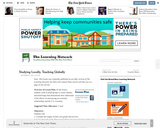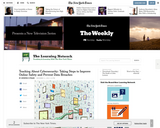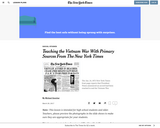
Students examine the state of the print newspaper industry, then debate its future.
- Provider:
- New York Times
- Author:
- The New York Times Learning Network
- Date Added:
- 06/24/2019

Students examine the state of the print newspaper industry, then debate its future.

In this lesson, students examine the state of the print newspaper industry, then debate its future.

Students learn about the physiological stress response, and then choose from a number of activities to explore various aspects of anxiety. Discussion questions, brain map, role play, stress log, and a warm-up are all included.

Students will create song lyrics celebrating the history of labor unions serving the entertainment industry, then create posters illustrating the importance of each union to the industry they represent.

In this lesson, students will create song lyrics celebrating the history of labor unions serving the entertainment industry, then create posters illustrating the importance of each union to the industry they represent.

Students work in small groups to create outlines and mind-maps that demonstrate their understanding of the effects of outsourcing on economic relationships and the U.S. economy.

Students identify the medicinal benefits, and ill effects, of a variety of controlled substances. They then determine whether or not they think hallucinogens should be researched for possible medicinal purposes.

Students will learn about the extent of cyberattacks just in the past year and the risks they pose for companies, governments and individuals. They also will learn about the steps individuals and organizations can take to better protect their data online, and will reflect on their own digital security practices.

This resource contains six ideas for teaching “Mockingbird” today, as well as resources, new and old, for connecting Harper Lee and her work to the world around us. Includes activities and connections for "Go Set a Watchman."

This resource contains six ideas for teaching "Mockingbird" today, as well as resources, new and old, for connecting Harper Lee and her work to the world around us. Includes activities and connections for "Go Set a Watchman."

Students will use The New York Times and George Orwell's Animal Farm and/or 1984 to explore the relevance of the novel in today's contemporary society and discern how many of the book"™s warnings are relevant today.

Six teaching ideas for F.Scott Fitzgerald's, The Great Gatsby including research, writing, and collaborative assignments.

Six teaching ideas for F.Scott Fitzgerald's, The Great Gatsby including research, writing, and collaborative assignments.

This resource from the New York Times includes six teaching ideas for teaching The Kite Runner including informational readings, videos, and links.

This resource from the New York Times includes six teaching ideas for teaching The Kite Runner including informational readings, videos, and links.

This resource from the New York Times contains a rich collection of lessons, artciles, and activities for teaching William Golding's Lord of the Flies.

This resource from the New York Times contains a rich collection of lessons, artciles, and activities for teaching William Golding's Lord of the Flies.

In this lesson, students assume the role of historians analyzing primary source material - investigating archival New York Times articles for evidence about the causes and consequences of the atrocities against Armenians. Following, there are opportunities to explore related contemporary issues, including laws prohibiting discussion or denial of historical events and current United States policy refusing to officially recognize the Armenian genocide.

This lesson aims to take advantage of The New York Times as a living textbook - a source that chronicled the Vietnam War as it took place and that continues to look back with the benefit of hindsight. The page offers a curated selection of three types of primary sources: photographs, original articles, and first-person accounts. Scroll down to find accompanying teaching activities that build students' analytical skills while encouraging inquiry.

Students consider the presence of Al Qaeda in various countries, with particular attention to its recent growth in Yemen, post 9/11. Working in groups, they investigate key people, places and institutions related to Al Qaeda and counterterrorism efforts, and create a maps or diagrams.